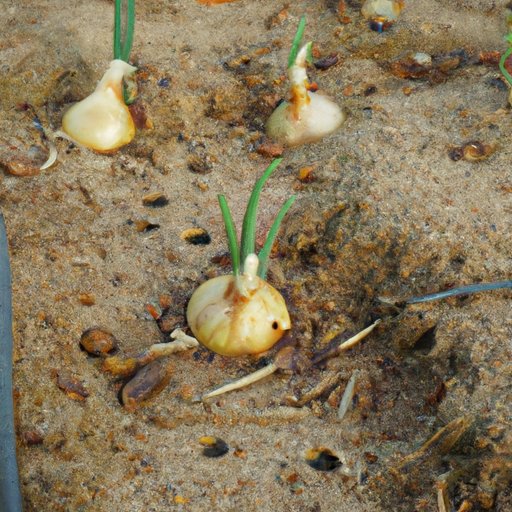Introduction
Onions are a staple in cooking and can add flavor to any dish. However, planting onions in your garden can be a challenge for many gardeners. In this article, we will explore seven steps to successfully plant onions in your garden, dos and don’ts of planting onions, tips for growing big onions, planting onions in containers, and troubleshooting common onion planting problems.
7 Steps to Successfully Planting Onions in Your Garden
The first step to successfully planting onions in your garden is selecting the right location. Make sure the area gets at least six hours of sunlight each day, and the soil is well-draining. Onions prefer soil with a pH between 6.0 and 7.0.
The next step is preparing the soil. Remove any weeds or debris from the area, and work the soil to a depth of 6-8 inches. Add compost or aged manure to the soil to improve soil quality and fertility.
Once the soil is prepared, it’s time to plant the onions. You can start with either onion seed or sets. Onion seed takes longer to mature, but it’s less expensive. Onion sets are easy to plant and mature quickly, but they can be more susceptible to disease.
Plant the onion sets or seed 1 inch deep in the soil and about 4 inches apart. Cover them with soil, and press down lightly. Water the area well, and add a layer of mulch to help retain moisture in the soil.
Caring for the onion plants after planting is also essential. Water them regularly, giving them about an inch of water each week. Fertilize them every 2-3 weeks with a balanced fertilizer. Onions prefer a nitrogen-rich fertilizer, but too much nitrogen can lead to leafy growth and small bulbs.
The Dos and Don’ts of Planting Onions
Choosing the right time of year can be crucial for onion planting success. Onions are cool-weather crops that grow best when planted in early spring or late summer. It’s best to avoid planting onions during the hottest part of the summer or in areas with high humidity.
When selecting the right variety, choose one that’s suited for your climate and soil type. Avoid planting onions too close together, as this can lead to smaller bulbs. Weeds can also compete with onions for soil nutrients, so it’s crucial to keep the area weed-free.
Factors such as temperature, weather, and sunlight can affect onion growth. Onions grow best in temperatures between 55-75°F. They also need at least six hours of sunlight each day, so it’s essential to select an area that gets enough sunlight.
Tips for Growing Big Onions
Proper soil management is essential for growing big onions. Onions prefer well-draining soil that’s rich in organic matter. Avoid compacted soil, as it can stunt onion growth. Adding compost or aged manure to the soil can also improve soil quality and fertility.
The right fertilizer can also lead to bigger onions. Onions prefer a balanced fertilizer with a higher nitrogen content in the early stages of growth. Once the bulbs start to form, switch to a fertilizer with less nitrogen to prevent leafy growth.
Pruning can also help onions grow bigger. Remove any flower stems that appear, as these can take resources away from bulb growth. It’s also essential to thin out the onions, so each bulb has enough room to grow.
How to Plant Onions in Containers
Planting onions in containers can be a great option for some gardeners, especially those with limited space. Select a container that’s at least 6-8 inches deep and has drainage holes. Fill the container with well-draining potting soil, leaving about an inch of space at the top.
Plant the onion sets or seed 1 inch deep in the soil and about 4 inches apart. Cover them with soil, and press down lightly. Water the container well, and keep the soil moist but not waterlogged. Fertilize the onion plants every 2-3 weeks with a balanced fertilizer.
Troubleshooting Common Onion Planting Problems
Like all plants, onions can be susceptible to pests and diseases. Onion maggots and rust disease are common problems that can affect onion growth. To prevent these problems, avoid planting onions in the same spot each year and remove any infected plants immediately.
Weather-related issues such as drought or heavy rainfall can also affect onion growth. Onions prefer well-draining soil but need regular watering. During dry periods, make sure to water the onions regularly. Too much water can lead to rot and disease, so it’s essential to find the right balance.
Conclusion
Planting onions can be a challenge, but by following these tips and tricks, you can successfully grow onions in your garden. Remember to choose the right location, prepare the soil properly, and care for the onion plants after planting. With proper care, you can enjoy the delicious taste of homegrown onions.
If you’d like to learn more about growing onions, check out gardening books or online resources about onion gardening.
